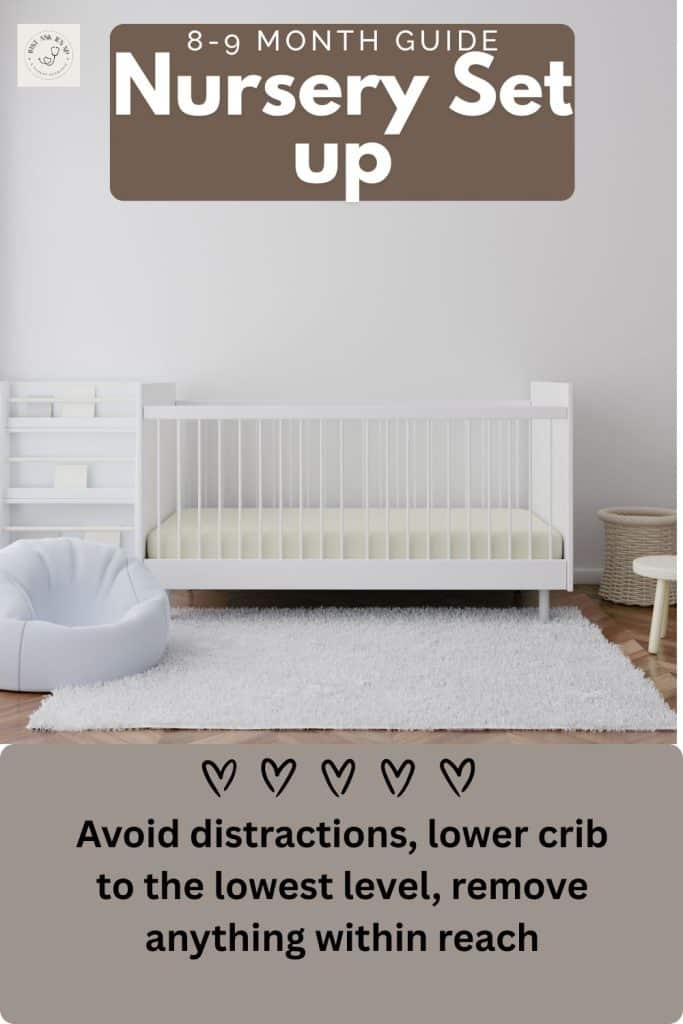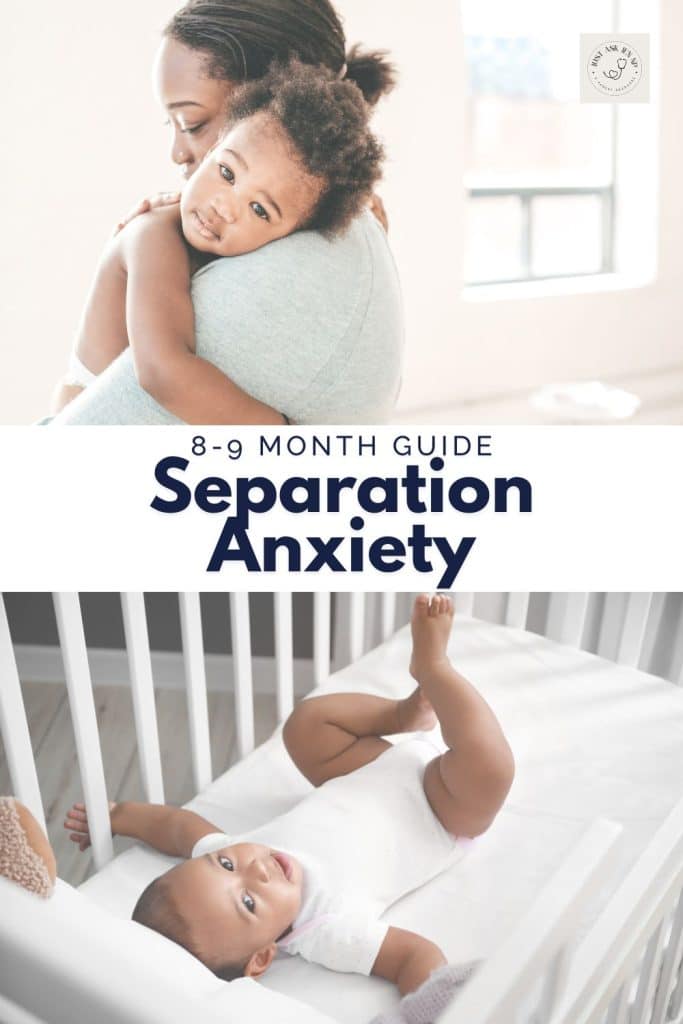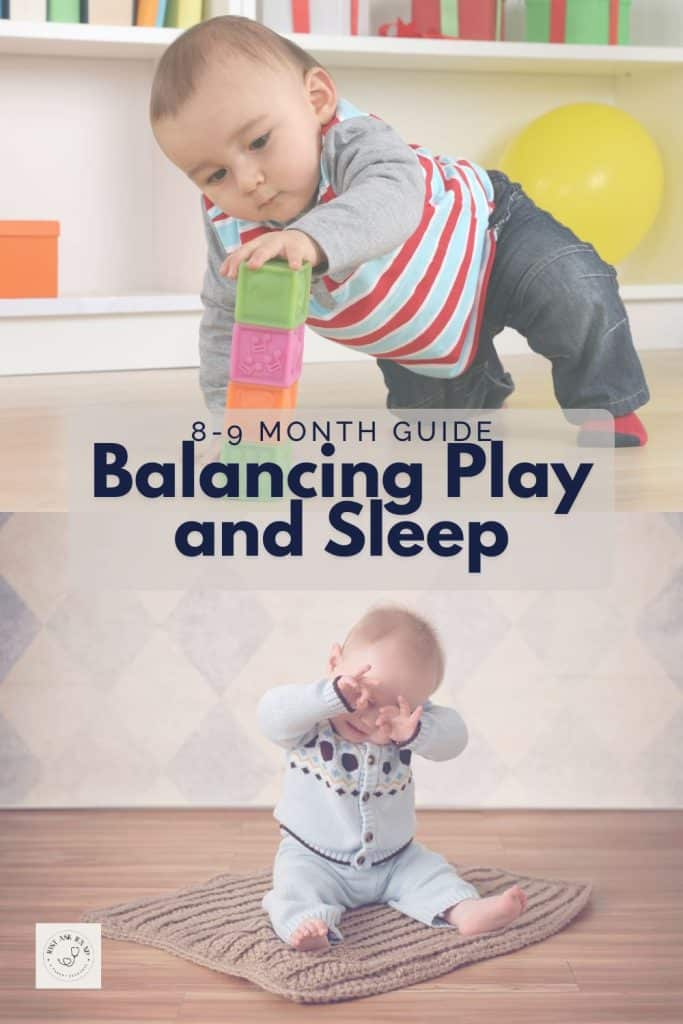8-9 Month Old Sleep: Maintaining Sleep Foundations
Welcome to the ninth installment of our infant sleep series! The 8-9 month old sleep period often brings new sleep challenges as many babies master the milestone of pulling to stand, adding a vertical dimension to their sleep space.
This developmental leap, combined with continued separation anxiety and growing cognitive awareness, creates unique sleep considerations. Despite these challenges, with consistent approaches and appropriate expectations, families can preserve the healthy sleep foundations established in previous months.
If you missed the 7-8 month old sleep post, click here.

Sleep Development: 8 to 9 Months
As your baby moves through their ninth month, several important sleep developments typically emerge:
- Standing mastery: Many babies pull to stand in crib and need help returning to lying position
- Extended wake windows: Capacity to stay awake 3-4 hours comfortably between sleep periods
- Greater sleep pattern consistency: More predictable sleep and wake times day-to-day
- Deeper sleep consolidation: Many babies sleeping longer stretches at night
- Enhanced memory for routines: Stronger recognition and anticipation of sleep patterns
- Clearer sleep preferences: More defined preferences for sleep conditions and positions
- Increased vocalization: New sounds and early words appearing around sleep transitions
- Social awareness: Growing understanding of social dynamics affecting bedtime
Typical Expectations for 8-9 Month Old Sleep
During this age range, average sleep patterns include:
- Total sleep: 12-14 hours per 24-hour period
- Night sleep: Typically 10-12 hours with 0-1 feedings for most babies
- Naps: Two naps totaling 2-3 hours of daytime sleep
- Awake windows: Approximately 3-4 hours between sleep periods
- Morning nap: Typically occurs 2.5-3 hours after morning wake-up
- Afternoon nap: Usually begins 3-3.5 hours after morning nap ends
- Bedtime: Often settles between 6:30-8:00pm based on nap quality and timing
- Morning wake time: Typically consistent between 6:00-7:30am
Managing the Standing Milestone & 8-9 Month Old Sleep

The milestone of pulling to stand creates several new sleep challenges:
- Getting stuck standing: Many babies can pull up but can’t get back down
- Excitement about new skill: Practicing standing during what should be sleep time
- Falls and bumps: Risk of losing balance while standing in crib
- Delayed sleep onset: Time spent standing instead of settling to sleep
- Wake cycle perpetuation: Standing during night wakings, becoming fully awake
- Safety concerns: New considerations for crib setup and sleep environment
Supporting sleep during the standing phase:
DO:
- Practice transitions during awake time (standing to sitting to lying down)
- Demonstrate and physically guide the movement sequence
- Create games that reinforce getting down from standing
- Provide ample standing practice during awake periods
- Check that sleep sack allows for safe movement
- Use verbal cues that will help during night wakings (“down” or “sit”)
- Consider sleep sacks designed for standing babies (with foot openings)
- Briefly intervene if baby is truly stuck and distressed
AVOID:
- Rushing to assist the moment baby stands in crib
- Creating new sleep associations during this developmental phase
- Removing crib sides or transitioning to toddler bed prematurely
- Expressing frustration about new standing behavior
- Overreacting to minor bumps or falls within the crib
- Excessively entertaining baby who has pulled to stand at bedtime
Creating a Safe Sleep Environment for Standers

As your baby begins standing, several safety considerations become crucial:
- Crib setup:
- Mattress at absolute lowest setting
- Ensure stability of crib on all sides
- No bumpers or padding that could become foot holds
- Furniture positioned away from crib to prevent climbing out
- No mobiles or toys that could be reached while standing
- Nothing hanging near crib that could entangle standing baby
- Sleep attire:
- Sleep sacks that accommodate standing (either with leg openings or stretchy enough for mobility)
- Properly sized to prevent tripping
- No loose or dangling parts that could catch on crib
- Monitoring:
- Video monitor positioned to view entire crib, including standing height
- Sound monitor sensitive enough to hear movement/distress
- Regular safety checks of crib hardware as increased movement puts more stress on components
Persistent Separation Anxiety and Sleep

For many babies, separation anxiety remains significant at 8-9 months, continuing to impact sleep:
- Bedtime resistance: Often intensifies with growing awareness
- More dramatic protests: Louder, more persistent crying at separation
- Heightened awareness of departures: Greater recognition when parents prepare to leave
- Wake and check behavior: Briefly waking to confirm parent’s absence then becoming distressed
- Early morning separation distress: Increased sensitivity during lighter morning sleep
Effective strategies for ongoing separation anxiety:
- Predictable presence: Consistent routine around departures and returns
- Comfort object importance: Increasing significance of loveys or transitional objects
- Separation practice: Brief separations during daytime to build confidence
- Visual reassurance: Photo of parents nearby or book featuring parents
- Verbal cues: Consistent phrases signaling departure and return
- Gradual separation: Sitting nearby then gradually moving father away during settling
- Confident departures: Calm, matter-of-fact goodbyes rather than anxious lingering
- Consistent response: Similar approach to all separations, daytime and nighttime
Managing Sleep Through Developmental Leaps

The 8-9 month period often coincides with significant cognitive development:
- Object permanence solidifying: Understanding objects (and people) exist when not visible
- Cause and effect mastery: Greater understanding of how actions create results
- Memory enhancement: Improved recall of routines and expectations
- Spatial awareness: Better understanding of the physical environment
- Language comprehension: Following simple directions and recognizing more words
- Emotional development: More complex emotional responses and recognition
These cognitive leaps frequently affect sleep through:
- Increased mental stimulation leading to difficulty winding down
- Processing new information during sleep (more active sleep periods)
- Testing boundaries around sleep routines
- Greater awareness of environmental changes during light sleep phases
- Excitement about new abilities overriding sleep drive
Supporting sleep through cognitive leaps:
- Balance stimulation:
- Provide cognitive challenges earlier in wake windows
- Allow longer wind-down periods before sleep
- Create clearer transitions between active learning and rest times
- Consistent boundaries:
- Maintain clear limits while acknowledging new awareness
- Use simple, consistent language around sleep expectations
- Prepare for more testing of boundaries around sleep times
- Sleep environment optimization:
- Remove potential distractions from sleep space
- Consider white noise to mask household sounds
- Ensure complete darkness during sleep periods
Fine-Tuning the Two-Nap Schedule
By 8-9 months, most babies benefit from refinements to their two-nap schedule:
Ideal timing framework:
- Morning wake-up: Consistent time between 6:00-7:30am
- First wake window: 3-3.5 hours (morning nap around 9:30-10:30am)
- Morning nap: 1-1.5 hours
- Midday wake window: 3-3.5 hours
- Afternoon nap: 1-1.5 hours (starting between 2:00-3:30pm)
- Final wake window: 3.5-4 hours
- Bedtime: Between 7:00-8:00pm, adjusted based on nap quality
Schedule optimization strategies:
- Both naps becoming more equal in length (unlike earlier months when morning nap was often longer)
- Wake windows gradually extending (typically 3-4 hours at this age)
- Morning nap timing setting the framework for the entire day
- If either nap is skipped or severely shortened, consider moving bedtime earlier
- Watch for signs of sleep pressure building too quickly or too slowly
Warning signs of schedule problems:
- Taking more than 20 minutes to fall asleep for naps
- Very short naps (less than 45 minutes consistently)
- Extreme fussiness in the late afternoon
- Fighting bedtime but showing clear overtiredness
- Multiple night wakings that seem related to daytime schedule issues
Managing Nap Transitions and Timing
At 8-9 months, nap transitions require finesse:
Tips for smooth nap transitions:
- Consistent pre-nap routine: 10-15 minutes of calming activities before each nap
- Clear environmental cues: Similar conditions for each sleep period
- Watch sleepy windows: Learn to identify optimal timing when sleep pressure is sufficient but not excessive
- Avoid overtiredness: Recognize that fighting sleep often indicates overtiredness rather than not being ready
- Independent sleep skills: Continuing to place baby down awake for all sleep periods
- Schedule flexibility: Adjust afternoon timing based on morning nap quality
- Weekend consistency: Maintaining similar timing on weekends and weekdays
Managing nap disruptions:
- If morning nap is missed: Offer earlier afternoon nap and earlier bedtime
- If afternoon nap is missed: Move bedtime significantly earlier (up to 1-1.5 hours)
- If nap is short: Try brief intervention to extend, but if unsuccessful, adjust next wake window
- If away from home: Bring familiar sleep cues (sleep sack, white noise, lovey if used)
Nighttime Sleep Consolidation
By 8-9 months, nighttime sleep typically shows continued consolidation:
- Extended sleep stretches: Many babies achieving 8-11 hour consolidated stretches
- More predictable waking patterns: Consistent timing of any remaining night wakings
- Reduced feeding needs: Many babies needing only one or no night feedings
- Self-soothing improvement: Greater ability to return to sleep independently after brief awakenings
- Sleep cycle transitions: Smoother transitions between sleep cycles
- Early morning stabilization: More consistent early morning sleep patterns
Supporting nighttime consolidation:
- Review sleep onset associations:
- Ensure baby falls asleep independently at bedtime
- Maintain consistent response to night wakings
- Avoid creating new sleep associations during developmental transitions
- Assess feeding patterns:
- Review daytime nutrition to ensure adequate intake
- Consider timing of last feeding and bedtime
- Consult with pediatrician about remaining night feeds
- Evaluate schedule impacts:
- Ensure daytime sleep is appropriate (not too much/too little)
- Check that bedtime isn’t too early or too late
- Monitor wake windows for appropriate sleep pressure
Managing Bedtime Resistance
Many parents notice increased bedtime resistance at 8-9 months due to:
- Greater awareness of bedtime meaning separation
- Enhanced ability to communicate desires and protests
- Testing boundaries and parental responses
- Excitement about new skills and not wanting to miss out
- Inadequate wind-down time before sleep routine
- Schedule misalignment (overtiredness or undertiredness)

Effective approaches to bedtime resistance:
- Predictable wind-down: Start transition to sleep 30-45 minutes before desired bedtime
- Clear routine sequence: Consistent order of pre-sleep activities
- Boundary setting: Loving but firm limits on routine extensions (“one more book”)
- Appropriate timing: Ensure bedtime aligns with actual sleepiness
- Environment management: Dimming lights and reducing stimulation gradually
- Consistent response: Similar approach to protests each night
- Earlier start: Beginning routine before overtiredness sets in
Traveling with 8-9 Month Olds

Travel presents unique challenges with 8-9 month olds due to:
- Greater awareness of environmental changes
- Stronger sleep preferences and associations
- Excitement/overstimulation in new environments
- Disrupted timing due to activities or time zones
- Different sleep spaces affecting sense of security
Travel sleep strategies:
- Maintain sleep cues:
- Bring familiar sleep sack, white noise machine, lovey if used
- Follow similar routine sequence even in new environment
- Use same key phrases/songs associated with sleep
- Environment optimization:
- Create darkness (travel blackout solutions for windows)
- Maintain appropriate temperature
- Consider room arrangement to minimize distractions
- Create separate sleep space when possible
- Schedule considerations:
- Preserve nap timing when possible
- Allow 1-2 days of adjustment for time zone changes
- Consider slightly earlier bedtime if daytime is stimulating
- Plan travel around sleep times when feasible
Preparing for 9-10 Month Developments
As you approach the 10-month mark, begin preparing for these upcoming changes:
- Increased mobility: Cruising along furniture, perhaps early steps with support
- Enhanced communication: First words or consistent gestures affecting sleep routine
- Growing independence: More defined preferences and resistance
- Schedule evolution: Potential for slightly longer wake windows
- Sleep position preference: Stronger preferences for specific sleep positions
- Night waking pattern changes: Often a reduction in night wakings or shift in timing
- Morning wake time consistency: Greater regularity in wake time
- Nap length stabilization: More predictable nap duration patterns
Final Thoughts
The 8-9 month old sleep period represents a fascinating intersection of physical mastery, cognitive development, and emotional growth. While new skills like standing and heightened separation awareness create temporary sleep challenges, they also signal your baby’s healthy development and growing independence.
By maintaining consistent sleep foundations while adapting to your baby’s new abilities, you create both the structure and flexibility needed during this dynamic phase. Remember that temporary disruptions are normal during periods of intense development, and consistency in your approach helps your baby navigate these changes with security.
In our next post, we’ll cover months 9-10, when many babies solidify their mobility skills, continue language development, and begin preparing for the eventual transition to a one-nap schedule that will come in the months ahead.
For more information on development expectations, check out this link https://raisingchildren.net.au/babies/development/development-tracker-3-12-months/8-9-months
Disclaimer: This information is intended for educational purposes only and is not a substitute for personalized medical advice. Always consult with your pediatric healthcare provider regarding your specific situation and concerns.
